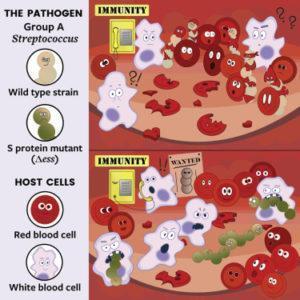Streptococcus pyogenes (group A Streptococcus, GAS) causes a multitude of diseases ranging from strep throat (very common in children) to rheumatic fever and the rare post-streptococcal glomerulonephritis in adults. Over half a billion GAS infections are recorded annually, despite the low death rate ( < 1%), 18 million cases of GAS infection are very severe and challenging to treat. Currently no vaccine against GAS exists, and antibiotic treatment is not always successful.
GAS has evolved multiple mechanisms to elude immunity and secretes multiple virulence factors that enable survival during infection. Many of these factors such as Streptolysin O and CAMP factor have been described, while several other proteins involved in pathogenicity remain unknown. Wierzbicki et al., utilised Biomimetic Virulomics a nanotechnology-enabled affinity enrichment coupled with multiplexed quantitative proteomics platform (Distler & Tenzer 2017; Lapek et al., 2017) to enrich red blood cell (RBC)-specific effector proteins secreted by GAS. Briefly, RBC biomimetic nanosponges are mixed with GAS culture supernatant secreted protein, proteins that bind to the nanosponges are then identified using proteomic platforms. One of the proteins they identified was SPy_0802 which they named S protein. Using ex vivo and in vivo murine experiments using wild type GAS and GAS mutant with S protein deletion, they showed that S protein is an important virulence factor involved in GAS molecular mimicry. Specifically GAS uses S protein to bind to RBC fragments which it “expresses” on it surface, shielding it from phagocytosis by macrophages. This finding provides a link between GAS hemolysis and pathogenesis, where “GAS utilizes lysed RBCs as immune camouflage.”
Wierzbicki et al., also demonstrated that deletion of S protein results in down regulation of other virulence factors such as M protein, a protein essential for survival in blood and phagocytosis evasion. Additionally, deletion of S protein results in reduced bacterial pathogenesis leading to reduced bacterial survival. Importance of S protein in GAS pathogenesis makes it an ideal target for therapeutics.
Journal Article: Wierzbicki et al., 2019. Group A Streptococcal S Protein Utilizes Red Blood Cells as Immune Camouflage and Is a Critical Determinant for Immune Evasion. Cell Reports












